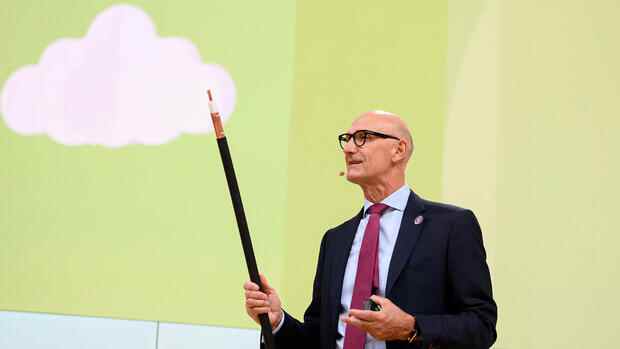Hamburg According to company circles, the final decision was made on Wednesday evening in Bonn: Deutsche Telekom is selling the majority of its radio tower business to two investors from North America.
The Canadian Brookfield Asset Management and Digital Bridge from Florida, a specialist in digital infrastructure, are taking over 51 percent of the shares at a total valuation of around 17.5 billion euros. The rest remains with Telekom.
The Telekom supervisory board has already approved the deal. It is likely to go down in economic history as one of the largest infrastructure deals in Europe.
The deal will be officially announced this Thursday. According to insiders, it is based on a 30-year contract that regulates in detail access to the radio towers and the relevant conditions.
For example, Telekom is said to have reserved a buyback option in order to be able to regain the majority of its tower infrastructure if necessary. For a corresponding premium, of course.
Neither Telekom nor the two buyers wanted to comment on the information when asked.
“Despite their experience, they have never experienced anything like it.” An insider about the night-long negotiations
Most of Telekom’s radio tower business has been outsourced to Deutsche Funkturm GmbH (DFMG). It owns and operates a network of more than 33,000 mast locations where wireless service providers can mount their antennas.
The most important customer is Telekom itself. Last year, DFMG increased its operating result (Ebitda after leasing costs) by 6.3 percent to around 669 million euros. According to forecasts, it should rise to almost 700 million euros in the current year.
The daughter was considered the last jewel in the crown of Telekom management around CEO Timotheus Höttges. At first he was reluctant to decide to monetize this essential part of his infrastructure.
drama and night shifts
The sales negotiations were apparently correspondingly tough – with a downright dramatic finale. The team led by Telekom board member Thorsten Langheim, which worked out the deal, was forced to work night shifts several times in view of the surprising turns, according to Bonn. “Despite their experience, they have never experienced anything like this,” says an insider.
Mast Have
33,000
Locations
for radio masts is owned and operated by Deutsche Funkturm GmbH
In times of increasing digitization, operators of infrastructure for communication are considered lucrative but comparatively safe investments. In this scene, the DFMG enjoys the reputation of being managed particularly solidly – with corresponding growth prospects.
In view of the desirable property to buy, the finale turned into an investor thriller.
According to financial circles, at the weekend it was initially a competition between two financially strong bidders: The US financial investor KKR, which formed a consortium with the investment companies Global Infrastructure Partners and Stonepeak, competed with the Spanish mobile infrastructure giant Cellnex, which is responsible for the market for mobile communications infrastructure in Europe leads.
Both sides apparently advertised extremely passionately for their offers. Financially, the KKR consortium is said to have been in the lead recently. Cellnex, meanwhile, competed for the German towers with its experience and qualitatively more attractive conditions.
>> Read also: Funkloch disaster Germany – the end of the white spots
Telekom would have benefited from access to the Spaniards’ suppliers and technologies. According to insiders, Bonn initially received a Cellnex share of ten and later 20 percent. Ultimately, however, they probably did not want to go into the uncertainty associated with the recently falling share price shortly before a possible recession.
The defeat is bitter for Cellnex boss Tobías Martínez Gimeno, who has pushed his group to the top from Barcelona in recent years. Together with Telekom, Cellnex would have been unbeatable as the mobile communications champion in Europe. Both sides have known and valued each other since a cooperation in the Netherlands.
In the end, Digital Bridge from Florida reappeared on the tableau. That surprised even insiders. The Americans were there from the beginning, but apparently never at the top. CEO Marc Ganzi – like Cellnex initially – suddenly teamed up with Brookfield and won the betting against the remaining KKR consortium.
Night shifts with investors.
(Photo: picture alliance)
The polo player with contacts in the British royal family is regarded as a rather dazzling representative of his guild. He has known the infrastructure business for more than 20 years and at Digital Bridge consistently relies on the vein system of the digital society: fiber optics, fast 5G mobile communications, radio towers or data centers.
Ganzi, who began his career at Deutsche Bank, among others, is considered an entrepreneurial investor. According to official information, his company manages company shares worth around 47 billion US dollars.
Telekom expects a formal conclusion of the deal by the end of the year. First of all, the antitrust authorities have to agree.
Duo Höttges-Langheim should claim the deal as a success
CEO Höttges is likely to invest the inflowing capital in increasing the stake in the successful subsidiary T-Mobile US to a majority of 50.1 percent and in reducing the record debt of more than 132 billion euros. He had already announced both steps
Company experts are also speculating on possible acquisitions in the USA, which are now possible again after the recent tense financial situation.
The Höttges-Langheim duo, which freed Telekom from the rampant lethargy of the European telecommunications market with several transactions, could claim the deal as a success.
In Münster, where the DFMG headquarters are located, everything will remain the same for the time being. It is said that boss Bruno Jacobfeuerborn will continue to run the company under the new owners. Apparently, corresponding financial incentives are part of the overall package.
More: No more dead spots: How mobile phone providers are finally optimizing coverage
